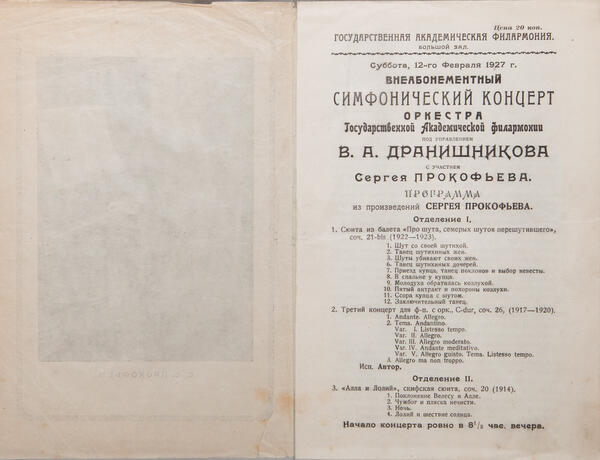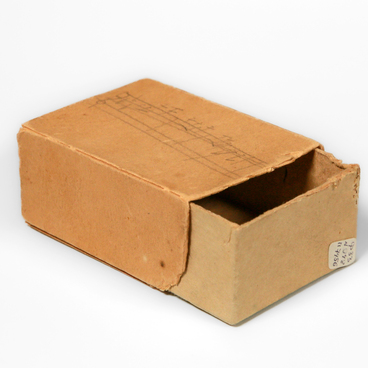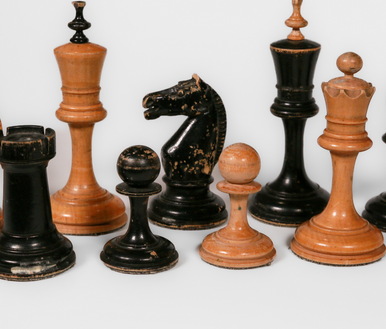In 1927, after nine years of living abroad, Sergei Prokofiev made his first return visit to the Soviet Union. In two months, he gave over twenty concerts in Moscow, Leningrad, Kharkov, Kiev, and Odessa.
At the Great Hall of the Moscow Conservatory, Prokofiev was met with thunderous applause. He reminisced, “As I appear the orchestra plays a flourish, then stands up and applauds. This turns into a large-scale and exceedingly long ovation on the part of both audience and orchestra. I stand for a long time, bow to all sides and really do not know what to do, sit down, but since the applause continues, again stand up, again bow and again do not know what to do… Finally, I get fed up and resolutely sit down… I was not at my most relaxed as I played but did quite well. There was only one incident: at one point in the third variation, I got in a bit of a muddle. I don’t remember exactly what happened, but in any event, it was nothing serious, and we quickly got back on an even keel again. In the end, the hall shouted its head off. I don’t think I ever got such a reception anywhere. I am called out over and over again. As an encore, I play first the ‘Gavotte’ from the ‘Classical Symphony’, then the ‘Toccata’. Both these party pieces go down well. At last, I retire to the Green Room while the orchestra plays the ‘Three Oranges Suite’. Following the tradition, the ‘March’ is repeated as an encore, and after that, I go out several times.”
The concert at the Leningrad Philharmonic was an equally resounding success. Prokofiev gave his own account of the event, “When I appeared Dranishnikov started playing the ‘Slava’ and set a colossal ovation in train, just about the same as the one at my first Moscow concert. It’s not worth describing it again, except for one amusing incident: after they had played the ‘Slava’ twice and had started it a third time, some very loud instruments came in one bar too late, and so the whole of this third rendition turned into a canon. Once started it was impossible to stop, and since they did not end together Dranishnikov had to play it a fourth time instead of three times.”
The program of Prokofiev’s concert included a suite from his ballet “Chout” (1922–1923), Piano Concerto No. 3 (1917–1920), and the “Scythian Suite” (1914). The concert was conducted by Vladimir Dranishnikov, with Prokofiev himself playing the solo part.
At the Great Hall of the Moscow Conservatory, Prokofiev was met with thunderous applause. He reminisced, “As I appear the orchestra plays a flourish, then stands up and applauds. This turns into a large-scale and exceedingly long ovation on the part of both audience and orchestra. I stand for a long time, bow to all sides and really do not know what to do, sit down, but since the applause continues, again stand up, again bow and again do not know what to do… Finally, I get fed up and resolutely sit down… I was not at my most relaxed as I played but did quite well. There was only one incident: at one point in the third variation, I got in a bit of a muddle. I don’t remember exactly what happened, but in any event, it was nothing serious, and we quickly got back on an even keel again. In the end, the hall shouted its head off. I don’t think I ever got such a reception anywhere. I am called out over and over again. As an encore, I play first the ‘Gavotte’ from the ‘Classical Symphony’, then the ‘Toccata’. Both these party pieces go down well. At last, I retire to the Green Room while the orchestra plays the ‘Three Oranges Suite’. Following the tradition, the ‘March’ is repeated as an encore, and after that, I go out several times.”
The concert at the Leningrad Philharmonic was an equally resounding success. Prokofiev gave his own account of the event, “When I appeared Dranishnikov started playing the ‘Slava’ and set a colossal ovation in train, just about the same as the one at my first Moscow concert. It’s not worth describing it again, except for one amusing incident: after they had played the ‘Slava’ twice and had started it a third time, some very loud instruments came in one bar too late, and so the whole of this third rendition turned into a canon. Once started it was impossible to stop, and since they did not end together Dranishnikov had to play it a fourth time instead of three times.”
The program of Prokofiev’s concert included a suite from his ballet “Chout” (1922–1923), Piano Concerto No. 3 (1917–1920), and the “Scythian Suite” (1914). The concert was conducted by Vladimir Dranishnikov, with Prokofiev himself playing the solo part.



